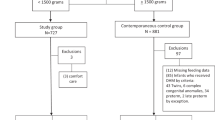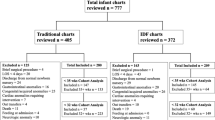Abstract
Objective:
Rates of breast milk feeding at hospital discharge are low in premature infants due to the many associated challenges. Although there are many benefits associated with breast milk, the effects of direct breast-feeding in the neonatal intensive care unit (NICU) have not been identified. The purpose of this study was to investigate the relationship between direct breast-feeding (infant sucking directly from the breast) and duration and success with breast milk feedings until discharge in premature infants.
Study Design:
This retrospective cohort was conducted on 66 very-low birth weight infants whose mothers initiated breast milk feedings in the NICU. Chart review revealed documented type (breast milk with or without fortifiers or type of infant formula), volume and mode (nasogastric tube, breast or bottle) of all gastric feeds for each day of NICU hospitalization. From this documentation, whether the mother initiated breast milk feedings, the number of times the mother put the infant to breast, the gestational age of the first direct breast-feeding, whether the first oral feeding was at the breast, the duration of breast milk feedings and whether breast milk feedings continued until NICU discharge were determined. Associations between breast-feeding participatory factors and breast milk feeding outcomes were investigated using linear and logistic regression.
Result:
Positive associations were found between breast milk feedings at discharge and mothers putting their infants directly to breast in the NICU (P=0.0005). The duration of breast milk feedings was associated with: mothers putting their infants directly to breast (P=0.0110), whether the first oral sucking feeding was at the breast (P=0.0108) and the gestational age of the first breast-feeding attempt (P<0.0001).
Conclusion:
Breast milk feedings are encouraged in most NICU's, but direct breast-feeding is often overlooked as an important area of research in the tightly controlled environment of the NICU. This study demonstrates a link between direct breast-feeding behaviors in the NICU and success with provision of milk at discharge, as well as how early participation can be an important factor in the breast-feeding process for mothers of NICU infants. More research on the effects of direct breast-feeding is warranted.
This is a preview of subscription content, access via your institution
Access options
Subscribe to this journal
Receive 12 print issues and online access
$259.00 per year
only $21.58 per issue
Buy this article
- Purchase on Springer Link
- Instant access to full article PDF
Prices may be subject to local taxes which are calculated during checkout

Similar content being viewed by others
References
Gartner LM, Morton J, Lawrence RA, Naylor AJ, O’Hare D, Schanler RJ et al. Breastfeeding and the use of human milk. Pediatrics 2005; 115 (2): 496–506.
Callen J, Pinelli J . A review of the literature examining the benefits and challenges, incidence and duration, and barriers to breastfeeding in preterm infants. Adv Neonatal Care 2005; 5 (2): 72–88; quiz 89–92.
Hill PD, Andersen JL, Ledbetter RJ . Delayed initiation of breast-feeding the preterm infant. J Perinat Neonatal Nurs 1995; 9 (2): 10–20.
de Azevedo M, Mendes EN . Maintenance of lactation: a challenge for hospitalized premature infant's mothers. Rev Gaucha Enferm 2008; 29 (1): 68–75.
McGrath JM, Braescu AV . State of the science: feeding readiness in the preterm infant. J Perinat Neonatal Nurs 2004; 18 (4): 353–368; quiz 369–70.
Kavanaugh K, Mead L, Meier P, Mangurten HH . Getting enough: mothers’ concerns about breastfeeding a preterm infant after discharge. J Obstet Gynecol Neonatal Nurs 1995; 24 (1): 23–32.
Pineda RG, Foss J, Richards L, Pane CA . Breastfeeding changes for VLBW infants in the NICU following staff education. Neonatal Netw 2009; 28 (5): 311–319.
Yip E, Lee J, Sheehy Y . Breast-feeding in neonatal intensive care. J Paediatr Child Health 1996; 32 (4): 296–298.
Powers NG, Bloom B, Peabody J, Clark R . Site of care influences breastmilk feedings at NICU discharge. J Perinatol 2003; 23 (1): 10–13.
Davanzo R, Ronfani L, Brovedani P, Demarini S, Breastfeeding in Neonatal Intensive Care Unit Study Group. Breast feeding very-low-birthweight infants at discharge: a multicentre study using WHO definitions. Paediatr Perinat Epidemiol 2009; 23 (6): 591–596.
Lee HC, Gould JB . Factors influencing breast milk versus formula feeding at discharge for very low birth weight infants in California. J Pediatr 2009; 155 (5): 657–662 e1–2.
Yokoyama Y, Ueda T, Irahara M, Aono T . Releases of oxytocin and prolactin during breast massage and suckling in puerperal women. Eur J Obstet Gynecol Reprod Biol 1994; 53 (1): 17–20.
McNeilly AS, Robinson IC, Houston MJ, Howie PW . Release of oxytocin and prolactin in response to suckling. Br Med J (Clin Res Ed) 1983; 286 (6361): 257–259.
Ueda T, Yokoyama Y, Irahara M, Aono T . Influence of psychological stress on suckling-induced pulsatile oxytocin release. Obstet Gynecol 1994; 84 (2): 259–262.
Heinrichs M, Meinlschmidt G, Neumann I, Wagner S, Kirschbaum C, Ehlert U et al. Effects of suckling on hypothalamic–pituitary–adrenal axis responses to psychosocial stress in postpartum lactating women. J Clin Endocrinol Metab 2001; 86 (10): 4798–4804.
Heinrichs M, Neumann I, Ehlert U . Lactation and stress: protective effects of breast-feeding in humans. Stress 2002; 5 (3): 195–203.
Lupton D, Fenwick J . ‘They’ve forgotten that I’m the mum’: constructing and practising motherhood in special care nurseries. Soc Sci Med 2001; 53 (8): 1011–1021.
Aagaard H, Hall EO . Mothers’ experiences of having a preterm infant in the neonatal care unit: a meta-synthesis. J Pediatr Nurs 2008; 23 (3): e26–e36.
Wigert H, Johansson R, Berg M, Hellström AL . Mothers’ experiences of having their newborn child in a neonatal intensive care unit. Scand J Caring Sci 2006; 20 (1): 35–41.
Smith MM, Durkin M, Hinton VJ, Bellinger D, Kuhn L . Initiation of breastfeeding among mothers of very low birth weight infants. Pediatrics 2003; 111 (6 Part 1): 1337–1342.
Author information
Authors and Affiliations
Corresponding author
Ethics declarations
Competing interests
The author declares no conflict of interest.
Rights and permissions
About this article
Cite this article
Pineda, R. Direct breast-feeding in the neonatal intensive care unit: is it important?. J Perinatol 31, 540–545 (2011). https://doi.org/10.1038/jp.2010.205
Received:
Revised:
Accepted:
Published:
Issue Date:
DOI: https://doi.org/10.1038/jp.2010.205
Keywords
This article is cited by
-
Mothers’ experiences of breast milk expression during separation from their hospitalized infants: a systematic review of qualitative evidence
BMC Pregnancy and Childbirth (2024)
-
Exploring factors influencing the uptake of kangaroo mother care: key informant interviews with parents
BMC Pregnancy and Childbirth (2023)
-
Effect of cue-based feeding on time to nipple feed and time to discharge in very low birth weight infants
Scientific Reports (2023)
-
Successful breastfeeding following a level II NICU stay in Qatar – a longitudinal study
International Breastfeeding Journal (2022)
-
Breastfeeding experiences and perspectives on support among Chinese mothers separated from their hospitalized preterm infants: a qualitative study
International Breastfeeding Journal (2019)



